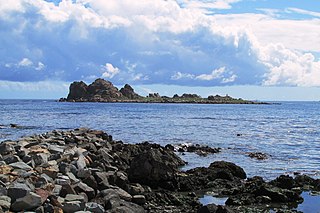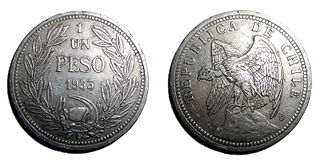
Chile, officially the Republic of Chile, is a South American country occupying a long, narrow strip of land between the Andes to the east and the Pacific Ocean to the west. It borders Peru to the north, Bolivia to the northeast, Argentina to the east, and the Drake Passage in the far south. Chilean territory includes the Pacific islands of Juan Fernández, Salas y Gómez, Desventuradas, and Easter Island in Oceania. Chile also claims about 1,250,000 square kilometres (480,000 sq mi) of Antarctica, although all claims are suspended under the Antarctic Treaty.

The Coquimbo Region is one of Chile's 16 first order administrative divisions. It is some 400 km north of the capital, Santiago.

Chillán It is the capital city of the Ñuble Region in the Diguillín Province of Chile located about 400 km (249 mi) south of the country's capital, Santiago, near the geographical center of the country. It is the capital of the new Ñuble Region since 6 September 2015. Within the city are a railway station, an inter-city bus terminal, an agricultural extension of the University of Concepción, and a regimental military base. The city includes a modern-style enclosed shopping mall in addition to the multi-block open-air street market where fruits, vegetables, crafts and clothing are sold. The nearby mountains are a popular skiing destination.

The Araucana is a breed of domestic chicken from Chile. Its name derives from the Araucanía region of Chile where it is believed to have originated. It lays blue-shelled eggs, one of very few breeds that do so.

The University of Chile is a public university in Santiago, Chile. It was founded on November 19, 1842 and inaugurated on September 17, 1843. It is the oldest and the most prestigious in the country. It was established as the continuation of the former colonial Royal University of San Felipe (1738), and has a rich history in academic, scientific and social outreach. The university seeks to solve national and regional issues and to contribute to the development of Chile. It is recognized as one of the best universities Latin America for its leadership and innovation in science, technology, social sciences, and arts through the functions of creation, extension, teaching, and research.

Tacna is the southernmost department in Peru. Present-day Tacna Department was occupied by the Chilean Army during the War of the Pacific from 1885 to 1929, when it was reincorporated into Peruvian soil; today, it is known for being one of the most patriotic areas in the country.

The Libertador General Bernardo O'Higgins Region, often shortened to O'Higgins Region, is one of Chile's 16 first order administrative divisions. It is subdivided into three provinces. It is named in honour of Bernardo O'Higgins Riquelme, one of Chile's founding fathers.

The Araucanía, Araucanía Region is one of Chile's 16 first order administrative divisions and comprises two provinces: Malleco in the north and Cautín in the south. Its capital and largest city is Temuco; other important cities include Angol and Villarrica.

Rancagua is a city and commune in central Chile and part of the Rancagua conurbation. It is the capital of the Cachapoal Province and of the O'Higgins Region, located 87 km (54 mi) south of the national capital of Santiago.

Cañete is a city and commune in Chile, located in the Arauco Province of the Biobío Region. It is located 135 km to the south of Concepción. Cañete is known as a "Historic City" as it is one of the oldest cities in country. The Battle of Tucapel and Pedro de Valdivia's death happened near the city's current location. Cañete was also an important location in the Arauco War.
Gregorio Billikopf is a mediator, author, and since 1981, a farm advisor specializing in labor management for the University of California, Davis. In May 2005, Billikopf accepted a visiting faculty appointment as an honorary professor of agricultural labor management at the University of Chile in Santiago. Billikopf is a frequent national and international speaker in his field.

Valdivia is a city and commune in southern Chile, administered by the Municipality of Valdivia. The city is named after its founder Pedro de Valdivia and is located at the confluence of the Calle-Calle, Valdivia, and Cau-Cau Rivers, approximately 15 km (9 mi) east of the coastal towns of Corral and Niebla. Since October 2007, Valdivia has been the capital of Los Ríos Region and is also the capital of Valdivia Province. The national census of 2002 recorded the commune of Valdivia as having 140,559 inhabitants (Valdivianos), of whom 127,750 were living in the city. The main economic activities of Valdivia include tourism, wood pulp manufacturing, forestry, metallurgy, and beer production. The city is also the home of the Austral University of Chile, founded in 1954 and the Centro de Estudios Científicos.

The economy of Chile has shifted substantially over time from the heterogeneous economies of the diverse indigenous peoples to an early husbandry-oriented economy and finally to one of raw material export and a large service sector. Chile's recent economic history (1973–) has been the focus of an extensive debate from which "neoliberalism" acquired its modern meaning.

Osorno is a city and commune in southern Chile and capital of Osorno Province in the Los Lagos Region. It had a population of 145,475, as of the 2002 census. It is located 945 kilometres (587 mi) south of the national capital of Santiago, 105 kilometres (65 mi) north of the regional capital of Puerto Montt and 260 kilometres (160 mi) west of the Argentine city of San Carlos de Bariloche, connected via International Route 215 through the Cardenal Antonio Samoré Pass. As such, it's a gateway for land access to the austral regions of Aysén and Magallanes, that would otherwise be accessible only by sea from the rest of the country.

The Football Federation of Chile is the governing body of football in Chile. It was founded June 19, 1895, making it the second oldest South American association football federation, and is a founding member of CONMEBOL in 1916. It supervises of the Chile national football team, Asociación Nacional de Fútbol Profesional: (National Association of Professional Football, originally called Asociación Central de Fútbol, or ACF, and Asociación Nacional de Fútbol Amateur.

The International Scout and Guide Fellowship (ISGF) is a worldwide organization of adults in support of Scouting and Guiding.
Indians in Chile form one of the smaller populations of the Indian diaspora. The large majority of them of Sindhi descent. A few Indians went to Chile in the 1920s. Later more Indians migrated there about 30 years ago - not only from India, but also from Hong Kong, Spain, Ivory Coast, Indonesia, Nigeria, Panama, the Philippines and Singapore.
The Chilean Athletics Federation is the governing body for the sport of athletics in Chile. Current president for the period 2014-2017 is Juan Luis Carter.
The Mapuche people of southern Chile and Argentina have a long history dating back as an archaeological culture to 600–500 BC. The Mapuche society had great transformations after Spanish contact in the mid–16th century. These changes included the adoption of Old World crops and animals and the onset of a rich Spanish–Mapuche trade in La Frontera and Valdivia. Despite these contacts Mapuche were never completely subjugated by the Spanish Empire. Between the 18th and 19th century Mapuche culture and people spread eastwards into the Pampas and the Patagonian plains. This vast new territory allowed Mapuche groups to control a substantial part of the salt and cattle trade in the Southern Cone.

















